Students On Board Floating Classroom Are Cleaning Up the Mississippi River


Members of Living Lands and Waters' Alternative Spring Break program have collected more than 100,000 pounds of trash from the Mississippi River every year since 2009. (Image: Rivers Are Life)
Whether it’s called “The Big Muddy,” “Old Man River,” “The Father of Waters,” or even “The Main Stream,” the Mississippi River has always been an enormous presence in American life. Ninety million people live in its watershed, and more than 60 billion gallons of fresh water is withdrawn from the river daily. Unfortunately, the biggest impact humans have on the mighty Mississippi is pollution from fertilizers, insecticides and trash — particularly single-use plastic.
For more than a decade, Living Lands and Waters, an environmental nonprofit devoted to cleaning up the Mississippi and its tributaries, has combined its efforts with education through its “floating classroom.” Based in Memphis, Tennessee, the classroom is a river barge upon which the nonprofit conducts 40-50 workshops annually, including an Alternative Spring Break program for college students. Operating nine months out of the year, the floating classroom has educated more than 24,000 students since 2012.
Even before the barge, college students from across the country converged in Memphis to clean up trash along the Mississippi and learn about the damages of pollution to the ecosystem. The Alternative Spring Break volunteers have collected more than 100,000 pounds of trash every year since 2009.
The floating classroom caught the attention of the environmental advocacy platform Rivers Are Life, which produced a short film called “Study Aboard” that chronicles Living Land and Waters’ 2023 spring break program.
Chad Pregracke, the founder and president of Living Lands and Waters, told Triple Pundit that the short film was “a perfect example of collaboration” between groups with similar aims.
“Rivers Are Life wanted to come see us in action and tell our story, which will hopefully be seen by a lot of people,” Pregracke said. “This story shows the impact that our volunteers have had and how one person can make a difference if they change their habits ever so slightly. Think of the impact if everyone watching changed one habit for the betterment of the environment. It would be huge.”
A key message the nonprofit tries to convey through the floating classroom is the importance of water conservation, he said.
“What we put in the water has a deep, long-term impact on what we eat, what we drink, and vegetation and wildlife,” Pregracke told 3p. “The sooner we all realize this we can hopefully protect our natural resources.”

Because the trash is not always easy to access, the organization’s clean-up efforts require walking along the riverbanks and picking up trash by hand or plucking debris from the rivers by boat. An excavator is used to move large objects, such as automobiles, from the riverbanks and water. Since its founding in 1998, Living Lands and Waters has harnessed the efforts of more than 126,000 volunteers in 21 states who have removed more than 13 million pounds of trash from the Mississippi, Pregracke said.
“Volunteers are the heart of our organization,” he said. “Without them we cannot do the work.”
A large majority of the 13 million pounds of trash collected is single-use plastics, 55-gallon barrels and tires, Pregracke said.
The impact of plastic pollution on the Mississippi is particularly troubling because plastics linger in the environment for centuries, causing hazards for wildlife and humans. Animals can choke on bags, balloons and straws mistaken for food. Or they can become entangled in fishing lines, the rings that hold six-packs of cans together, and other plastic trash.
This problem can’t be solved with river cleanups alone. Pregracke calls for more recycling and transitioning away from single-use plastic, too.
“Unfortunately, more single-use plastic is produced every day, which results in more being discarded,” he said.
A native of East Moline, Illinois, Pregracke spent most of his life on or near the Mississippi and one of its tributaries, the Illinois River. Between his childhood and first job as a clam digger, he soon realized he didn’t like what he saw above or below the river.
“As a teenager, I would camp on islands and go shell diving. I saw how trashed our river was, and I couldn’t stand it, so I decided to do something about it,” Pregracke said. “Anything you start from the ground up is hard. When I first started, I would go out and pick up trash from the river all day and soon realized I needed to get a boat to make a bigger impact.”
One day, while watching a NASCAR race on television, Pregracke noticed the race cars were covered with names of companies who sponsored the drivers.
“I figured, why can’t I do something like that? So, I grabbed the phonebook and started with the letter ‘A’ looking for larger companies in our area to call to see if they might be willing to donate,” Pregracke said. “From there, we just continued to grow. You will always have obstacles as you grow an organization, you just need to think outside of the box on how to overcome them.”
Over two decades after starting operations with a single boat, Living Lands and Waters’ fleet now includes four barges, two towboats, five workboats, an excavator and a crane.
“More than 18 million people get their drinking water from the Mississippi,” Pregracke said. “We know our efforts are helping provide cleaner drinking water and cleaner living conditions for both marine life and wildlife.”
Hydrogen from Biomass: Beyond Decarbonization


The Sierra Nevada Mountains in Yosemite National Park. (Image: Soly Moses/Pexels)
Most of the global hydrogen supply still comes from natural gas, but new alternatives are beginning to emerge. In addition to decarbonizing the hydrogen supply chain, alternative sourcing can also open up new economic development opportunities. In particular, hydrogen derived from biomass can help local communities participate in wider energy markets while addressing other urgent environmental and economic issues, too.
Alternative sources for hydrogen
Currently, 95 percent of the hydrogen produced in the United States comes from natural gas. If natural gas is eliminated from this supply chain, it would help decarbonize major industrial sectors that depend on hydrogen including transportation, fertilizer, food processing and pharmaceuticals, among others.
Clearing fossil energy resources from the supply chain would also reduce the carbon footprint related to steam reformation. Steam reformation is the most common process for extracting hydrogen from natural gas and other feedstocks. It is an energy-intensive process that requires high heat, ranging from 700 to 1,000 degrees Celsius.
“Steam reforming is endothermic — that is, heat must be supplied to the process for the reaction to proceed,” according to the U.S. Department of Energy.
Steam reformation is a mature technology that has dominated hydrogen production for many years, but alternatives are arising. Much of the activity is currently centered on electrolysis, which deploys renewable energy to jolt hydrogen from water.
Drawing hydrogen from biomass is another new area of activity. Within that field, attention has focused on pyrolysis, which refers to the gasification of biomass in an oxygen-free environment. As with steam reformation, pyrolysis systems require high heat. However, pyrolysis systems can run on the synthetic gas they produce from gasified biomass, eliminating the use of energy from outside sources.
Pyrolysis at work: the carbon-negative solution
Pyrolysis is considered to be a carbon-negative system because it produces a charcoal-like, carbon-sequestering substance called biochar, in addition to hydrogen and other fuels. Sometimes referred to as biocarbon, biochar is an effective soil enhancement that can increase crop yields while also helping to conserve water. Biochar is not yet widely used in the U.S., but efforts to scale up the production and application of biochar are underway.
One such project is taking place in California, where the state’s Department of Conservation launched a $50 million pilot project last year called Forest Biomass to Carbon-Negative Biofuels. The goal of the program is to convert forest and agricultural waste to hydrogen and biochar, with a focus on marketing these products within California.
“The impetus behind this program is to address serious and significant issues of forest health and wildfire risk in the Sierra Nevada,” according to the Department of Conservation. The agency also lists fossil fuel replacement and carbon sequestration among the benefits.
Decentralizing the energy infrastructure
The Forest Biomass program underscores how alternative hydrogen sourcing can enable local communities to deploy renewable resources to participate in energy markets. The program passed a milestone last spring with the selection of eight proposals for producing hydrogen and biochar in the Sierra Nevada region.
One of the eight proposals selected is a partnership between the pyrolysis firm Kore Infrastructure and the Tule River Economic Development Corporation. TREDC is owned by the Tule River Tribe, encompassing the traditional territories of the Yokuts people and headquartered in Porterville, California. The agency is governed by a board of directors consisting of tribal members and local business professionals.
The $500,000 funding award calls for Kore to construct a pyrolysis facility in Porterville. Construction is set to begin in 2024, with operation expected the following year. Once up and running, the facility will take in 48 tons per day of non-marketable forest waste and produce two metric tons of hydrogen daily along with 10 tons of biocarbon (note: the company refers to biocarbon and biochar interchangeably).
Kore plans to market the hydrogen to the Ports of Los Angeles and Long Beach for use in converting diesel-powered equipment to zero-emission fuel cells, helping to support broader seaport decarbonization initiatives. The Porterville facility may also supply hydrogen closer to home as local demand emerges.
The forest waste harvesting operation will take place in parts of the Sierra Nevada Forest that are already under management by TREDC. The proposal also involves plans to bring additional land under TREDC management. To supplement the forest waste, the pyrolysis facility will take in wood waste from orchards in the Central Valley region.
New economic development opportunities for local communities
Until now, TREDC has focused on small-scale, on-site economic development projects like gas stations and restaurants. The Porterville project is a significant pivot in a new direction, but it is also one that draws on local resources and experience.
“We have not done any other energy-related project, but the tribe has done forest management since the beginning of time,” Dennis Ickes, TREDC’s chief executive officer, told TriplePundit, referring to conservation practices that maintain healthy forests. “This project enables us to get a foothold in the market and be progressive in forest management.”
TREDC has also won grants for solar panels and electric vehicle chargers at its properties, but the pyrolysis project is an entirely new level of scale. It will occupy a 40-acre site owned by TREDC. A $3.2 million grant from the U.S. Department of Commerce will provide funding for basic infrastructure at the location including water, roads and electricity.
“Dead, dying, diseased or rotting wood can be chipped and left in place, burned in slash piles or composted. Currently, most is landfilled or burned,” Ickes said.
The option to burn agricultural waste will be all but eliminated in part of the region after 2025, as regulators seek to improve air quality in the San Joaquin Valley, Ickes said. Carbon-negative hydrogen production facilities like the Porterville project can provide farmers with an economical alternative.
“This is a problem that we are solving in a way that benefits the environment,” Ickes said. “We are taking carbon out.”
More decarbonization opportunities for farmers
Currently, the California Department of Food and Agriculture advises farmers to replace burning with chipping and composting, a practice known as whole orchard recycling.
Pyrolysis with hydrogen production is rapidly emerging as another option. In addition to the Forest Biomass program, the leading utility Southern California Gas Company announced plans for a major pyrolysis facility to process agriculture wood waste and nutshells into hydrogen and renewable natural gas in August.
Kore also anticipates that other projects will follow its TREDC facility. The company affirmed in a July statement that its future plans include tripling the initial size of the Porterville facility.
“Kore’s model is being closely considered and evaluated for replication by the Central Valley Orchard and Forest Management for several projects throughout the Central Valley,” according to the company.
The prospects for a rising bio-derived hydrogen market in California also increased last week, when the U.S. Department of Energy announced seven projects to win funding under the new Clean Hydrogen Hubs program. California won a $1.2 billion share for a proposal focused exclusively on electrolysis and biomass.
Fossil energy stakeholders are still aiming to maintain their edge on hydrogen production, but California wields a significant influence on national markets. If money talks — and it does — the new investments in public and private funding for hydrogen from biomass will benefit farmers, local communities and the statewide economy as a whole.
This Evidence-Based Solution Could End Global Poverty, But You Probably Haven't Heard of It


A market in Bangladesh, where the development organization BRAC pioneered the Graduation Approach. BRAC's program reached 9 million Bangladeshis from 2002 to 2021 and helped 95 percent of those people move out of extreme poverty. (Image: lau rey/Flickr)
As TriplePundit moves forward with our new editorial focus on solutions journalism, we've looked back at some of the top solutions proposed to address our most pressing environmental, social and economic challenges a decade ago. Now, we're looking ahead to learn more about the evidence-based responses that can further progress on these challenges into the future. Last week, we reviewed some of the highest-potential interventions to reduce greenhouse gas emissions and mitigate climate change — from reducing food waste to restoring tropical forests. Now, we're fixing our eyes on another persistent and pervasive challenge: global poverty.
When talking about how to address wealth and income disparities in the fight against poverty, similar interventions are often mentioned: direct cash transfers, increasing education levels among children, training farmers to produce better yields, improving healthcare services, empowering women and girls. All of these things can make a massive impact on their own. For example, empowering women and girls with social protections, family planning services, and equal pay for equal work could lift nearly 150 million people out of extreme poverty by 2030 on its own, according to estimates from U.N. Women. But what if we could bring all of these interventions together?
That's the concept behind the Graduation Approach — which the Brookings Institution, a U.S. economic think tank, called "the most widespread and well-researched version of a 'big push' poverty eradication method."
A "big push" to fight global poverty
"Big push" programs employ multiple interventions simultaneously or in sequence to address the multidimensional causes of global poverty. The Graduation model in particular was pioneered by the international development organization BRAC (then the Bangladesh Rural Advancement Committee) in 2002. It deploys evidence-based interventions at specific times to help individuals and families lift themselves from extreme poverty — defined as living on less than $US2.15 per day.
"These interventions are adapted to local requirements and generally include livelihood training, transfers of cash and productive assets, and encouragement of savings, all facilitated through in-person coaching," according to Brookings. "They focus on the needs of the household as a whole, with women usually as the primary program participants."
The long-term results impressed researchers and made the global community take notice. BRAC's Graduation program reached 9 million people in Bangladesh from 2002 to 2021 and helped 95 percent of those people move out of extreme poverty. "Based on the successes of the program, over 100 partners in nearly 50 countries have either piloted or implemented Graduation, reaching 14 million people and over 3 million total households," Brookings reported in 2021.
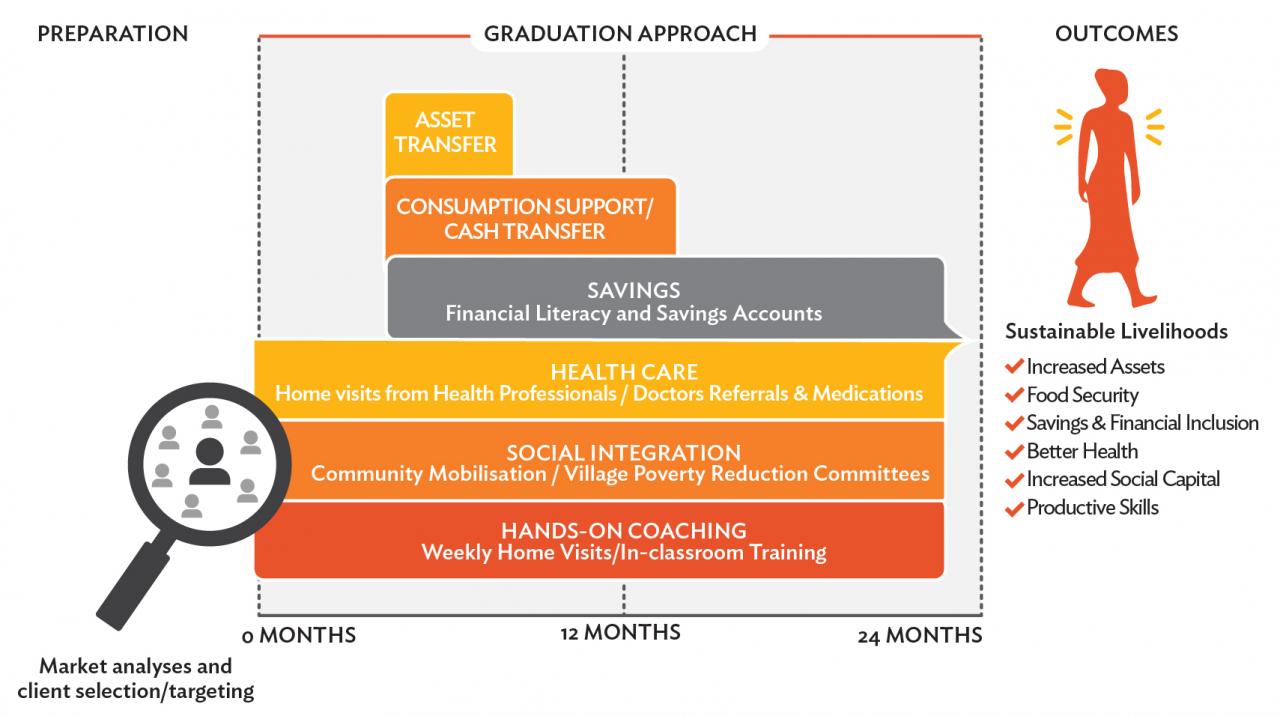
Understanding the global poverty problem
While wealth accumulation and access still varies widely around the world, global poverty has declined significantly since the end of the last century. Around 1.9 billion people, or 36 percent of the global population, lived in extreme poverty in 1990. By 2015, that number had fallen to 730 million, or around 9.9 percent of the world's population.
Even with backslides tied to the COVID-19 pandemic, which caused the first increase in global poverty seen in nearly two decades, the world is still making progress compared to where we came from. Last year, around 8 percent of the world's population — some 648 million people — faced extreme poverty.
While the numbers are headed in the right direction, the current state of things still leaves nearly 1 in 10 people globally subsisting on less than US$2.15 per day and struggling to meet their most basic expenses.
Beyond Bangladesh, researchers have documented compelling evidence that the Graduation model can begin to change the tide. A 2015 randomized study of 21,000 people across Ethiopia, Ghana, Honduras, India, Pakistan, and Peru showed that people had more assets and more savings 12 months after a three-year Graduation program ended. For every $1 spent on the program, participants received between $1.33 and $4.33 in benefits, depending on the country.
While the results of case studies like these are promising, how to effectively scale such programs around the world remains in question. When the Ford Foundation and the World Bank's Consultative Group to Assist the Poor (CGAP) studied 10 Graduation pilot projects in eight countries across Asia, Africa, and Latin America from 2006 to 2014, they found the results to be "extremely positive." But they hastened to note, "The very factors believed to make it so effective — highly personalized, wrap-around services delivered with compassionate, skilled and individual attention — also make the 'classic' Graduation Approach time- and labor-intensive and costly."
Still, the groups' research into programs run by both governments and non-governmental organization (NGOs) showed this roadblock is more than surmountable. "The scale-ups documented in the four case studies [in Colombia, Ethiopia, India and Peru) indicate that adaptations to suit local contexts, participant needs, and resource constraints can be managed successfully," they found.

Looking ahead to a more evidence-based approach to fighting global poverty
Economists Abhijit Banerjee and Esther Duflo won the Nobel Prize in 2019 for their emphasis on an evidence-based approach to fighting global poverty. They led the large-scale 2015 study on Graduation and followed up with another randomized controlled study published just last year.
The study found that former participants in a Graduation program in West Bengal, India, had higher incomes than the control group even a full decade later. It's often typical for the benefits of anti-poverty interventions to fade over time, so results like these put substantial evidence behind Graduation in the long-term.
It's not the only answer, of course, as other research found cash infusions alone to be just as or more effective than cash plus the other services offered through Graduation. Which approach wins out varies greatly by local context — demonstrating that although evidence and research can point us in the right direction, understanding local needs will always be imperative when tackling social challenges like poverty.
“We’re not trying to pit Graduation against anything else. Nothing we do is the one magic bullet to end poverty,” Shameran Abed, the executive director of BRAC International, told Vox last year. “But we think Graduation is extremely powerful, extremely compelling, and the evidence suggests that. So we would really like to see a much greater uptake of Graduation-type programming globally.”
BRAC provides resources and support to help other organizations and localities adopt Graduation-type programming. You can learn more here.
Are Paper Bottles the Future of Beverage Packaging?
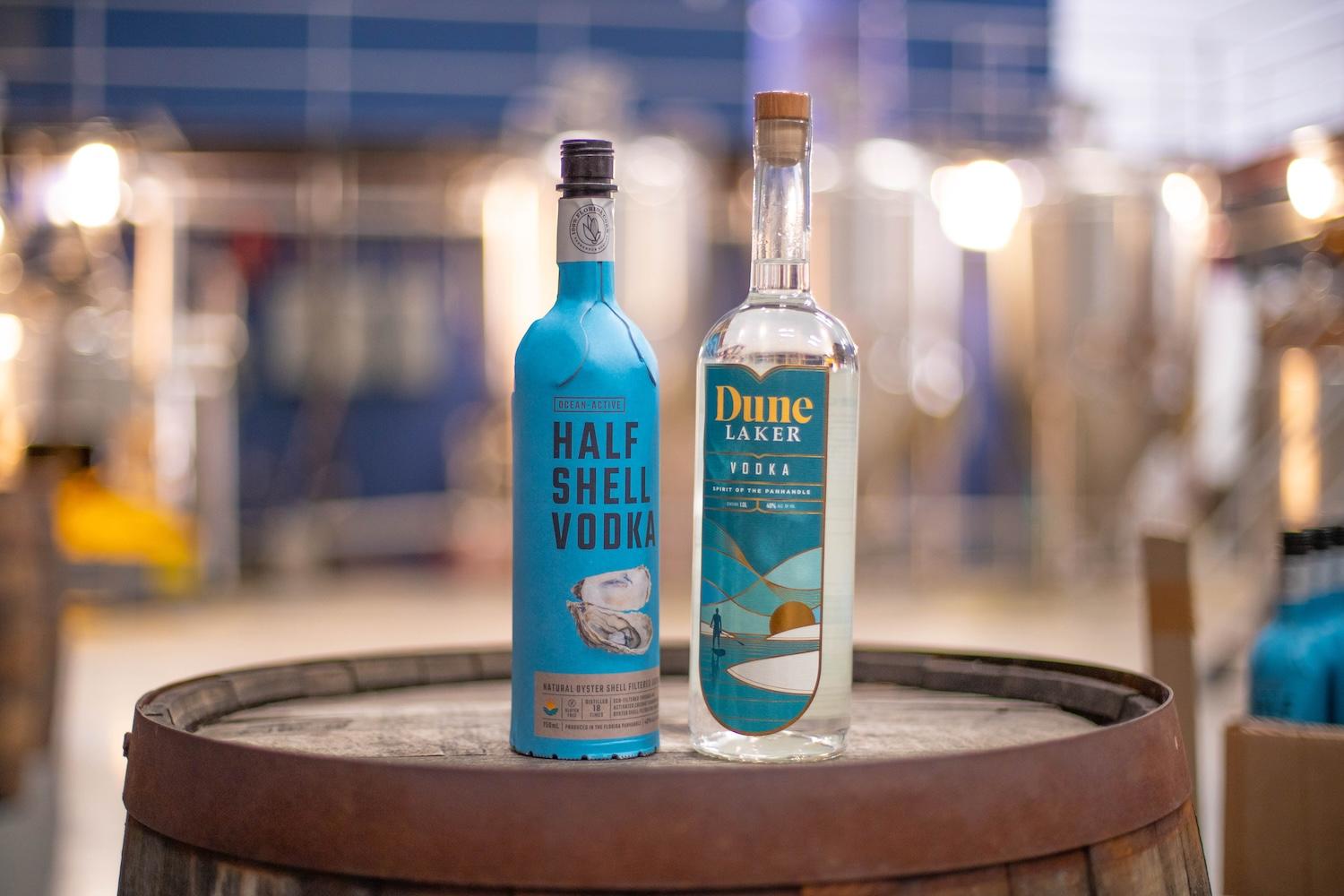

Distillery 98's Half Shell vodka (left) is packaged in 94 percent paper bottles from Frugalpac, and its Dune Laker vodka (right) is packaged in a standard glass bottle. (Image courtesy of Distillery 98)
We know that plastic waste is a colossal global problem. Landfills are overflowing, and plastic waste is causing severe degradation of the world's oceans and marine ecosystem. Yet we continue to produce, buy and use a record amount of single-use plastic. Around 36 percent of all plastic produced worldwide is used for packaging, much of it for single-use beverage and food containers.
To address this, some beverage brands are considering paper bottles as an alternative to plastic. But are paper bottles really a better solution than other alternatives?
The state of beverage packaging: Plastic, aluminum or glass?
More than a million bottles of water are sold around the world every minute, and the bottled water sector continues to boom. About 85 percent of all plastic bottles sold end up in a landfill or leak into the environment. And, of course, bottled water is only the tip of the iceberg when it comes to global plastic waste.
But addressing the problem isn’t always as simple as “stop drinking bottled water.” In both developed and developing countries, people often turn to bottled water because they see it as safer than the water coming from their taps — and in many cases, they’re right.
And while consumers claim to be changing their behavior to integrate sustainable and environmental considerations into their purchases when they can, 1 in 4 U.S. adults don’t know what makes a food or beverage product sustainable, according to a 2022 survey.
For beverage packaging, plastic is often replaced, by default, by glass. However, glass takes more resources and energy to produce. Making glass involves mining raw materials such as silica sand and dolomite that release pollution which, when inhaled, can cause the lung condition silicosis among workers in the industry. High temperatures are needed to melt these materials, a process powered by fossil fuels, and glass production also releases carbon dioxide. Further, glass weighs 20 times more than plastic, which means vehicles transporting glass bottles consume more fossil fuels to deliver the same amount of liquid as what comes in plastic.
As the sustainability challenges tied to glass become better understood, some have also considered aluminum to replace plastic in beverage packaging. Aluminum production consumes less energy and resources; cans are lighter than glass and aren’t made from fossil fuels like plastic. But production still requires the mining of bauxite ore and refining and smelting to create aluminum, which can be energy intensive.
A few different studies have compared the circularity of plastic, aluminum and glass. All of them found that the recycling efficiency of aluminum is 80 to 90 percent, followed by glass which is between 34 and 59 percent. Plastic recycling rates vary between 13 and 40 percent.
Since each of these materials come with their own set of trade-offs, some beverage companies are looking toward paper fiber as an alternative, a packaging material used widely across other sectors.
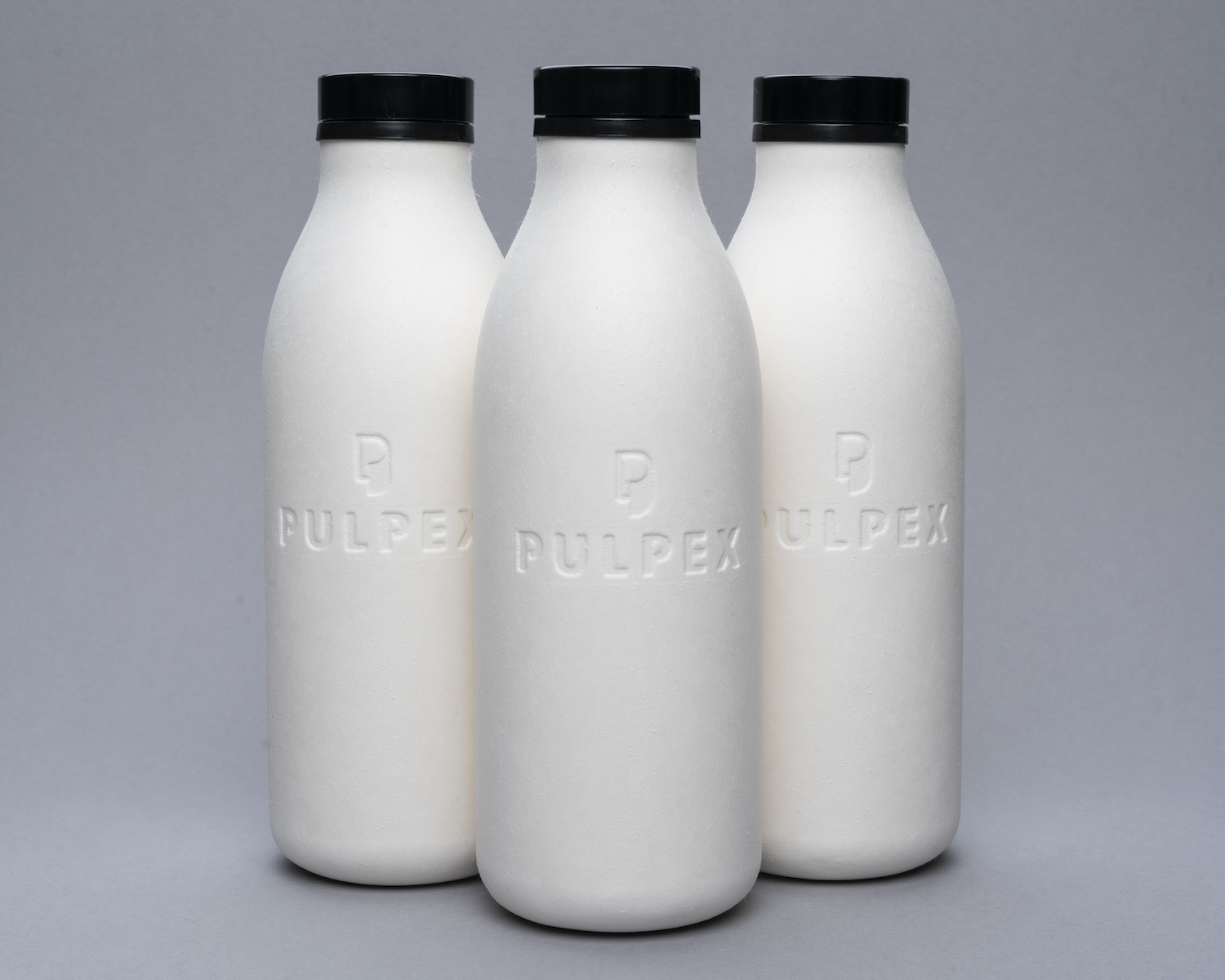
The reign of paper bottles might be on the horizon
“Glass, plastic and metal are all brilliant materials when deployed in the right regional environment, where the supporting infrastructure enables collection and recovery,” said Scott Winston, CEO at Pulpex, a renewable packaging technology company that has introduced a renewable fiber bottle made from sustainably-sourced wood. “However, we need to resist the temptation to introduce new, hybrid materials or technical solutions where circular packaging is not possible and the solution must go to a landfill or, at worst, it risks polluting an existing material recovery route.”
Established by the global spirits giant Diageo and Pilot Lite Venture Management, Pulpex recently secured $24.4 million in funding to deliver a commercially-scalable production line for its fiber bottles. Apart from Diageo, the parent company of brands like Johnnie Walker, Pulpex bottles are also being used by PepsiCo.
“Pulpex’s patented packaging solution uses the natural credentials of wood fibers and was developed to be sustainable as well as scalable,” Winston said. “[The bottles] technically perform as required to deliver product shelf life and filling infrastructure compatibility and, at their end-of-life, are curbside collected, sorted as paper and go on to become other fiber products.”
Pulpex aims to produce more than 2 billion paper bottles per year by 2028, in partnership with global brands and the fiber solutions company CMPC. “Pulpex’s commercial-scale production line in Cambridgeshire (U.K.) will be online by early 2024,” Winston said.
Florida-based micro-distillery Distillery 98 opted for the paper-based Frugalpac bottle instead of glass for its locally-sourced Half Shell Vodka when supply chain disruptions tied to COVID-19 made glass bottles inaccessible.
“It was hard to get bottles we liked that were manufactured in the way we wanted them,” said Distillery 98 co-owner and CEO Harrison Holditch. “When we came across the Frugalpac bottle, we saw a solution to our problem. We began to educate ourselves on the carbon footprint it takes to create a glass bottle overseas and also what it takes to recycle a glass bottle, which has a larger footprint than manufacturing one. The more we went down the road with this bottle, the more we found it to be a fit for us and what we believed was possible for our distillery."
Paper Bottle Co (PaBoCo), a Danish startup that makes another climate-friendly alternative container for beverages, also uses paper from sustainably-sourced wood.
“Our vision is to create a fully bio-based paper bottle to challenge the notion of what packaging can be,” said Michael Michelsen, commercial director at PaBoCo. “We are addressing this in innovation increments, launching newer generations of bottles and putting them into use with products and consumers even while we develop them. The way forward is by introducing paper bottles — as light as possible, with minimum emissions — and building the technology necessary to supply this solution.”
PaBoCo is already commercially viable and has been working with beverage companies including Coca-Cola, Carlsberg and Absolut. Absolut Vodka is to become the first global spirits brand to sell single-mold, paper-based bottles commercially in the U.K. as part of its journey to create a fully bio-based bottle.
PaBoCo says its paper bottle can reduce emissions by up to 32 percent compared to other materials used in the industry today. Its first-generation, single-mold bottles are made from 57 percent paper with what is described as "an integrated barrier of recyclable plastic.”
The plastic component, however, is still about 43 percent of the product’s weight and is made from polyethylene naphthalate (PEN), a plastic resin used in many industrial applications like food packaging, electronics and tires.
“Our next step to move the markets forward will be the introduction of a next-generation bottle consisting of minimum 85 percent paper,” Michelsen said. “Now that we have demonstrated paper bottles are here to stay, I believe we will see more variants of paper bottles appear, which also means a greater degree of adoption of such bottles across the industry.”
So, where does the paper come from?
The Frugalpac bottle is made from recycled paper, and the fiber sourced for both the PaBoCo and Pulpex bottles is certified by the Forest Stewardship Council (FSC), ensuring that the wood used comes from responsibly-managed forests.
“Responsibly-sourced wood can play a significant role in sustainable long-term solutions for beverage packaging,” said Monika Patel, director of communications and marketing for the FSC in Canada. “When sourced from well-managed forests, wood can be a renewable and low-impact material option. It provides an opportunity to reduce reliance on non-renewable resources and can offer numerous environmental and social benefits. If wood pulp is not harvested in a sustainable manner, it can lead to deforestation, habitat destruction, and negative impacts on local communities and biodiversity.”

Is paper really the solution?
Criticism of the paper bottle is scarce but not unfound, and it mostly revolves around the question of how practical paper bottles are for consumer recycling.
For instance, to recycle the 94 percent paper Frugalpac bottle, the user has to separate a plastic pouch from the paper bottle and place the items in their respective recycling bins. For PaBoCo, the recycling process is not clear, considering the bottle is not 100 percent paper yet.
Pulpex fiber bottles, on the other hand, are designed to be recycled just like paper. They do not contain a plastic liner that needs to be separated and can degrade in the natural environment in the worst-case event they end up as litter.
A lifecycle assessment from another sector sheds further light on the trade-offs at play.
Product sustainability consulting and software solutions company Trayak recently conducted a lifecycle assessment study with Dr. Bronner's, a U.S. producer of organic personal care products, to evaluate an alternative for the recycled plastic bottles the company uses for its signature soaps. Although not in the beverage industry, consumer goods companies like Dr. Bronner’s share the same sustainable packaging dilemma.
The study assessed the impact of four different packaging materials: the current bottle made with post-consumer recycled plastic, a fully paper bottle, a bottle made from post-consumer recycled aluminum, and a paper gable-top bottle carton that includes a plastic liner.
All four options came with their own benefits and drawbacks. And while Dr. Bronner’s plans to pursue reusable packaging in the long term, in the short term it opted for the gable-top carton for larger refill sizes of its soaps. Although the carton is not recyclable due to the plastic liner, its lifecycle environmental impact was found to be smaller than the other containers, even in a scenario where the carton is landfilled and all the other containers are recycled.
So, should brands focus on using recycled materials, prioritizing the recyclability of the package or accounting for full lifecycle impact? Is it preferable to be entirely plastic-free or to use a lighter package? There is much yet up for debate and evaluation in the long run.
The search for the best bottle continues
While paper bottles may provide a solution for the beverage industry, it is still a new concept and there is no quick or one-size-fits-all solution. Many variables need to be considered in evaluating the best solution per product type.
“There is no easy shift to adopting a renewable packaging solution,” Winston concluded. "What is needed is strategic vision on how to resolve these challenges and how to use available resources to support the correct outcomes rather than risk making the wrong decisions.”
Michelsen agreed. “The companies that want to transition quickly need to adopt a continuous innovation approach and need to cope with the challenge of being the first market entrant with their new packaging solutions,” he said. "Of course, they also need to work closely with companies to develop a feasible technical packaging solution, a task that takes a considerable amount of time, knowhow and dedication.”
Editor's Note: This story was updated on Friday, November 3. An earlier version of this story stated that Pulpex bottles are 100 percent paper. The bottles are around 98 percent fiber-based but also contain a water-based, spray-on barrier coating. The bottles are still biodegradable and recyclable as paper, according to the company.
This Subaru Retailer Lives its Purpose Hosting Fiestas for Shelter Animals


Fiesta Subaru is living up to its name in a big way. The Albuquerque, New Mexico, retailer brought the pet party directly to its campus with a brand new dog park. And it’s giving pet lovers a reason to celebrate by hosting on-site adoption events to connect shelter animals with their loving families. It’s all a part of the Subaru commitment to improve the lives of as many shelter animals as possible.
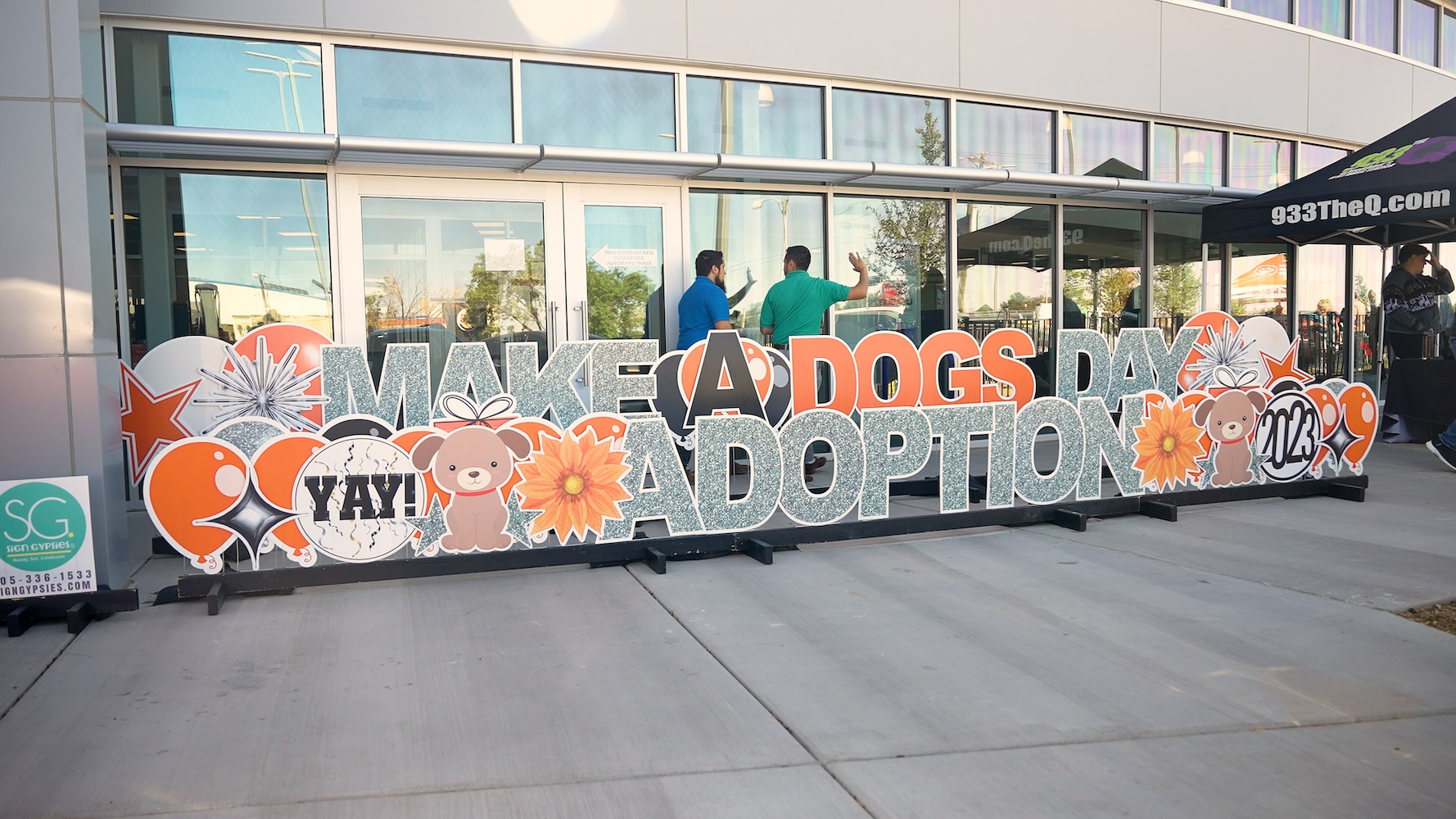
Pups on parade at Fiesta Subaru of Albuquerque
Fiesta Subaru has helped facilitate the adoption of 95 pets through the Subaru Loves Pets adoption campaign since 2020. “We host a pet adoption event roughly every six weeks,” Alexandra Kulach of Fiesta Subaru told TriplePundit. The number of dogs available to adopt has ranged anywhere from six to eight puppies in the same litter, to larger groups of 15 to 20 dogs. Moving forward, Kulach is excited about the opportunity to host a bigger cohort of potential adoptees thanks to the retailer’s new dog park and expanded facility. “We’re going to be able to connect even more animals to their forever home,” she beamed.
“We're hoping to have a lot more people, too,” Kulach said, describing the next event as a big shindig complete with food trucks and a pet frame for photo ops. Subaru owners are encouraged to come out with their pets, even if they’re not looking to adopt. “We are planning to have a really fun food truck come out. They're called Dawgs for a Cause, and they donate a portion of their proceeds from the day to charity as well,” she added.
Fiesta Subaru’s pet adoption events are already enormously successful. “There have been two instances in which we've hosted these pet adoption events and the dogs have all been adopted before we are even supposed to get started,” Kulach said. “The shelter had to then go back and bring more dogs, which was pretty exciting. Having the community come out and be so interested in adopting these dogs has been such a fun experience.”
Fiesta Subaru also helps new pet parents get a leg up from the get-go with a starter kit. “The New Pet Parent Kits are stocked full of goodies. There’s a bowl, as well as leash and bandana, and a waste bag holder,” Kulach said. “They also receive educational pamphlets that describe the responsibilities of pet care as well as how to keep your pet safe.” The pamphlets are also on display at the retailer for Subaru Loves Pets month in October. “Any customers who visit us can take one and have that information available to them,” she added.
As a prominent promoter of pet adoption, Subaru of America and its retailers have been inspiring customers to drive off the lot not just in a new car, but with a new furry family member as well for quite some time now. TriplePundit previously covered Maryland-based Fitzgerald Subaru’s adoption events, which have been going on regularly since 2014. Nationally, the automaker has partnered with auto shows since 2018, bringing adoptable pups to dozens of expos each year.
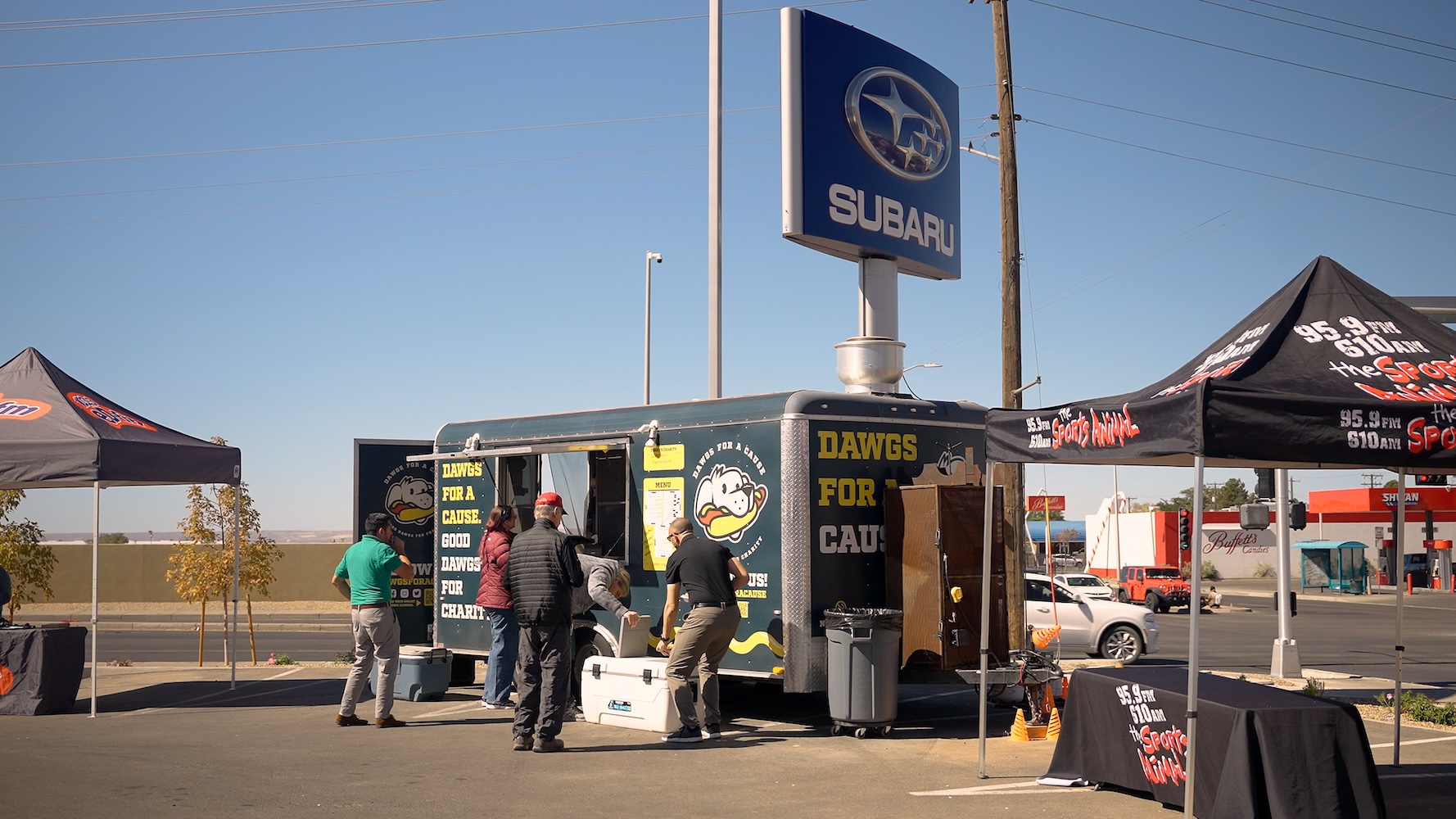
A purr-fect partnership
Fiesta Subaru hosts these pet adoption events in partnership with Watermelon Mountain Ranch, New Mexico’s largest no-kill animal shelter. “Watermelon Mountain Ranch Animal Center, located in northern Rio Rancho, is honored and humbled to be able to partner with Fiesta Subaru,” said Sara Heffern, executive director of the shelter about 15 miles outside Albuquerque.
“That hits hard for us, and it’s something we’re passionate about,” Derek Kulach of Fiesta Subaru said of the shelter’s no-kill status. “Which is why they are not only our Subaru Loves Pets partner, but they’re also one of our partners for the Share the Love Event.”
In addition to the big pet adoption event in October, Fiesta Subaru pledges $250 for every car sold during the Subaru Share the Love Event, which runs from mid-November to January. “And that’s matched by Subaru of America as well,” he explained.
“The money that has been donated to our organization over the last several years has helped to save thousands of pets' lives,” Heffern said. “Being a Subaru Share the Love Event partner has meant the absolute world to us, and being able to hold adoption events regularly at Fiesta Subaru has been absolutely amazing."
It’s a rewarding experience for the Fiesta Subaru team as well. They’ve been able to donate over $40,000 to support the cats and dogs at Watermelon Mountain Ranch since 2020. And, together with the funds matched by Subaru of America, nearly $80,000 has been donated so far.
Overall, Subaru and its retailers have donated over $51 million to national and local organizations, supporting the rescue, transportation and adoption of over 420,000 pets.
In addition to local retailers helping shelters like Watermelon Mountain Ranch, Subaru is also the largest corporate donor to the American Society for the Prevention of Cruelty to Animals (ASPCA), and since 2008 has donated over $35 million to the organization. That money makes a big difference considering nearly 6.3 million companion animals enter shelters nationwide every year, according to the ASPCA. Housing, caring for, adopting out, and returning strays to their owners doesn’t come cheap, after all. And by bringing dogs into the public domain and involving the community, Fiesta Subaru and Subaru of America are doing their part to get animals out of shelters and into loving homes.

Paws down, this Subaru retailer has a purpose-based design
Pet adoption events are poised to get even bigger thanks to the new onsite dog park at Fiesta Subaru. “This new facility was built with purpose for events like this, from where the location of the dog park is to how the facility is set up to be able to support bigger events,” Kulach said. “Now that we're in the new facility and operating out of there, I think it's something that's going to be an ever-growing thing for us.”
The dog park features a traditional double-gate entry so the pets are kept safe, as well as a water station, trash cans for pet waste, trees for shade, and a bench for pet parents to rest. “It's been a great success,” Alexandra Kulach said. “We continually have customers using it. They really seem to enjoy it, and the dogs especially enjoy it. You always hear dogs barking when you're outside because they're playing around all day long.”
It’s not just customers’ dogs either — Subaru employees are free to bring their dogs to work with them as well. “It brings a great energy to our store and it’s fun to have all the pets around,” she added. The team at Fiesta Subaru says they're eager to see some of the pets from their adoption events frolicking at the dog park in the near future. And, as one of five Albuquerque businesses that are trained to scan for microchips, they’re also proud to be a part of the solution helping to reunite lost pets with their families.

The retailer even has its own resident rescue — a cat named ONI. “When we first acquired the franchise, this cat showed up. And he became kind of the face of Fiesta Subaru. He walks around and greets people and surprisingly gets along very well with all the dogs that run around,” Derek Kulach explained. “We're happy to be a part of the 69 percent of Subaru customers who have a pet.”
With all that Fiesta Subaru is doing to advance pet adoption and care in its community, it’s no wonder the retailer has become a local beacon for pets and their owners. “Subaru Loves Pets is part of the larger Subaru Love Promise campaign that we’re a part of. Supporting the rescue, transportation and adoption of pets with Subaru of America is a huge deal for us,” he continued.
“We're just happy to be a small part of that and continue to grow our presence in helping pets get adopted,” he added. “We’re proud to be a part of it because Subaru is committed to doing good simply because it's just the right thing to do.” Whether it’s helping shelter dogs find their forever families, supporting cancer patients, donating vehicles to Meals on Wheels, or helping fund classrooms, Subaru of America is doing just that.
This article series is sponsored by Subaru and produced by the TriplePundit editorial team.
Images courtesy of Subaru
From Panic to Progress: Remediating PFAS in Groundwater
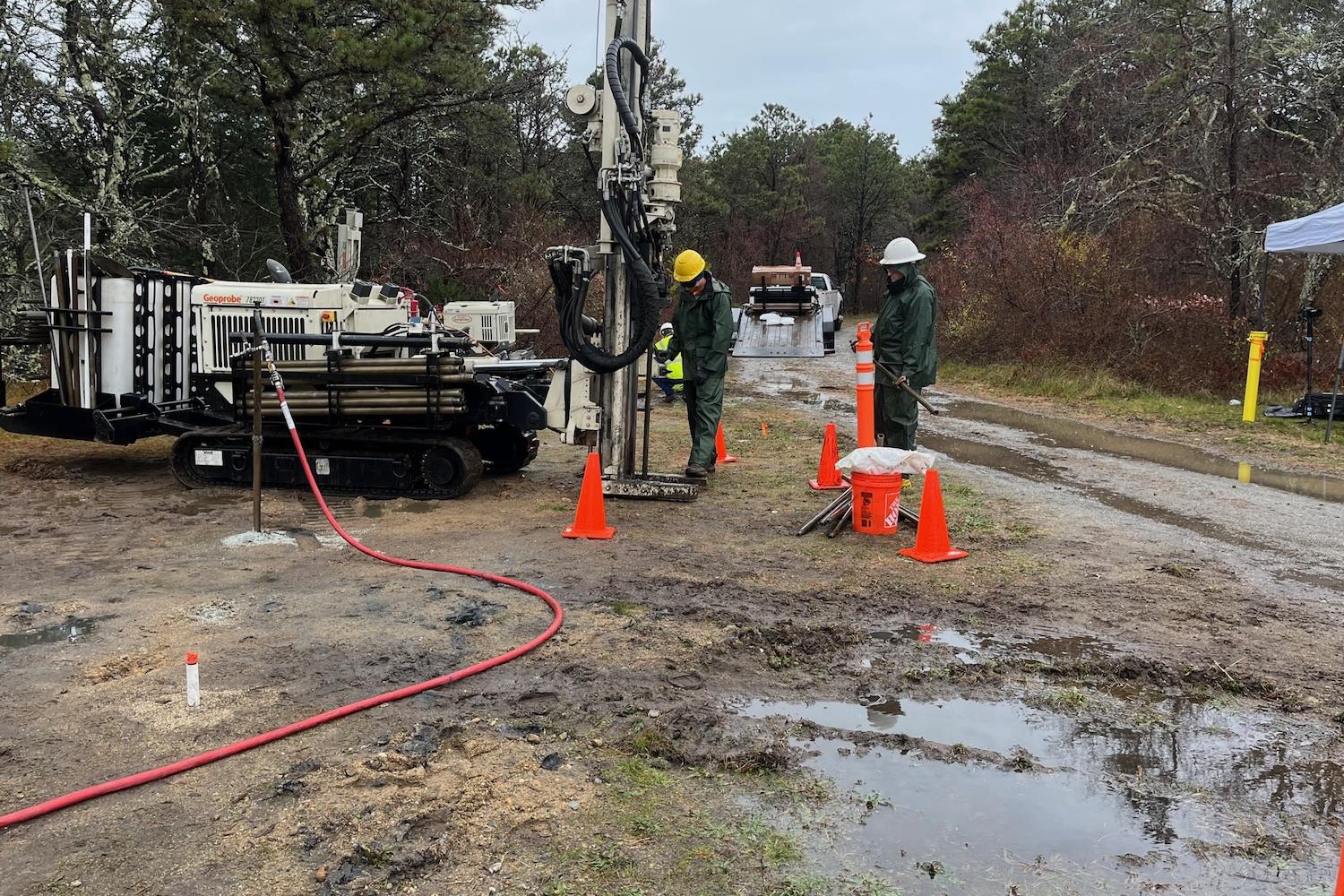
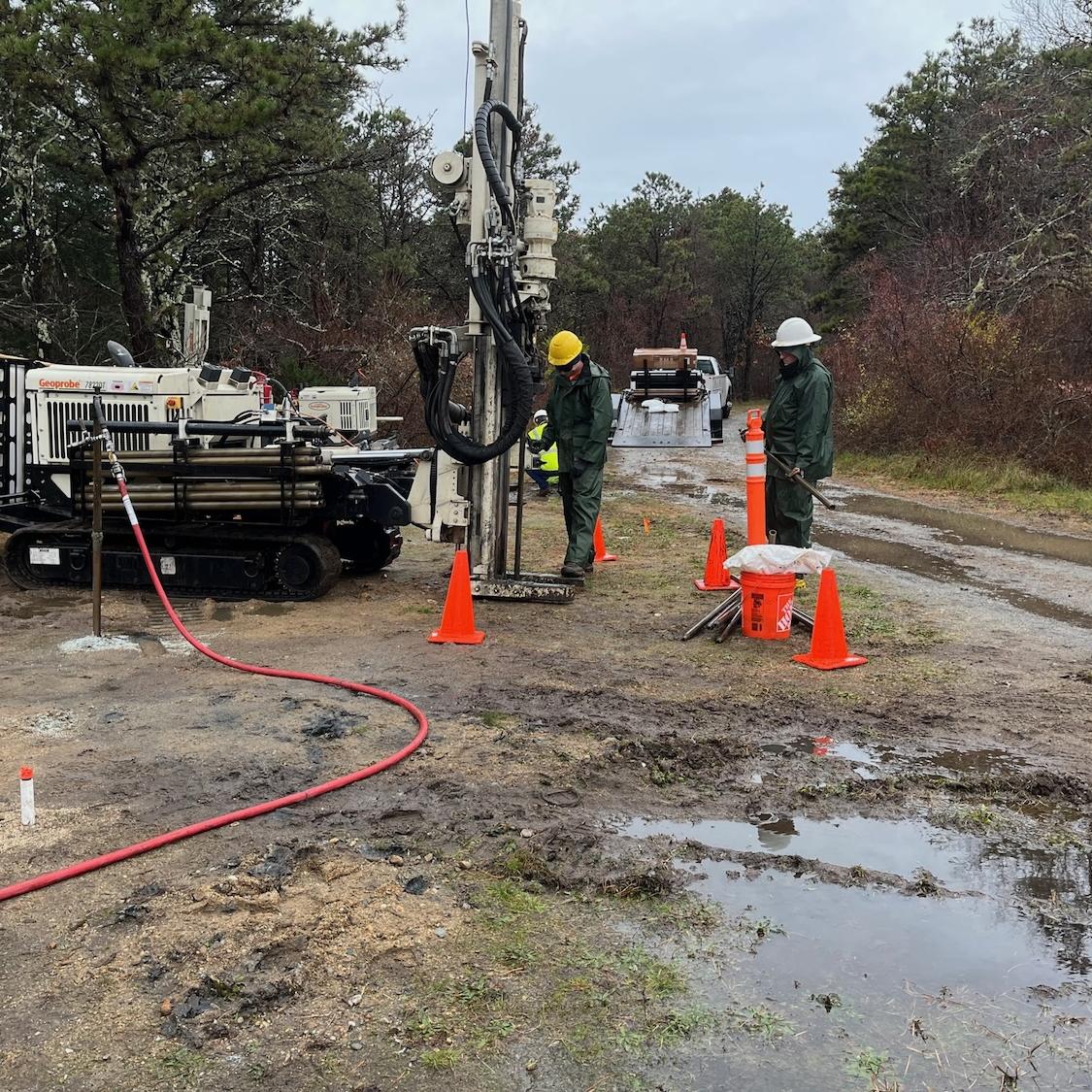
The colloidal activated carbon filtration product known as PlumeStop is injected into the subsurface to treat PFAS impacts at Martha’s Vineyard airport. (Image courtesy of Regenesis)
Media and government have turned on the spigot of information about the group of chemicals known as PFAS contaminating water sources. The public response to this serious situation includes questions like “should I be freaking out” and “what type of water filter should I buy.” Meanwhile, scientists, companies and governmental organizations seek to remediate the chemical compounds at the grander scale of groundwater, long before they make it to the tap.
One approach offers a promising track record: colloidal activated carbon (CAC), a mixture that can be gravity-fed or low-pressure injected into the soil at a contaminated area. There, PFAS adheres to the mixture and can be left in situ (Latin for “on site” or “in place”) for years. The colloid is a blend where the different components don’t separate — like how egg yolk keeps oil from separating in mayonnaise — and it captures PFAS molecules while letting water molecules pass through.
The value of getting PFAS out of groundwater
Studies show that exposure to PFAS (short for perfluoroalkyl and polyfluoroalkyl substances) is a pervasive problem for many reasons. The class of substances includes over 12,000 chemicals, according to the U.S. Geological Survey. Often called “forever chemicals” because of the inability of the strong fluorine and carbon molecule bonds to break down on their own, they stay in the human body for years and increasingly accumulate.
The U.S. Geological Survey reported this summer that at least 45 percent of U.S. tap water contains one or more of 32 types of PFAS. The U.S. Centers for Disease Control and Prevention (CDC) says most people in the nation have it in their blood. The chemicals are linked to cancers, reproductive damage, immunological problems, infant and child development disruption, and organ disease, among numerous health concerns.
And the effects are not just in humans. Fish, wildlife, livestock and plants also contain PFAS. The substances are, therefore, in food.
PFAS use provides water-resistant properties to rugs and jackets, adhesion to glues and tapes, flame-retardants to building materials and pajamas, and fire-extinguishing capabilities to foams, to name just a few uses since World War II. While some PFAS-containing products can pose an exposure risk to humans, the average person is most likely to take in PFAS by drinking contaminated water. Those who work with producing or employing PFAS-intensive products have the added vulnerabilities of inhalation and constant skin contact.
That’s why getting PFAS out of groundwater is critical.
Groundwater not only feeds drinkable water sources, but also the entire global water cycle through evaporation and precipitation. What goes up must come down, which explains why even remote parts of the planet now register PFAS contamination.
Intercepting these substances in groundwater at industrial sites, airports and military bases makes in situ colloidal activated carbon (CAC) a promising remediation technology at scale.
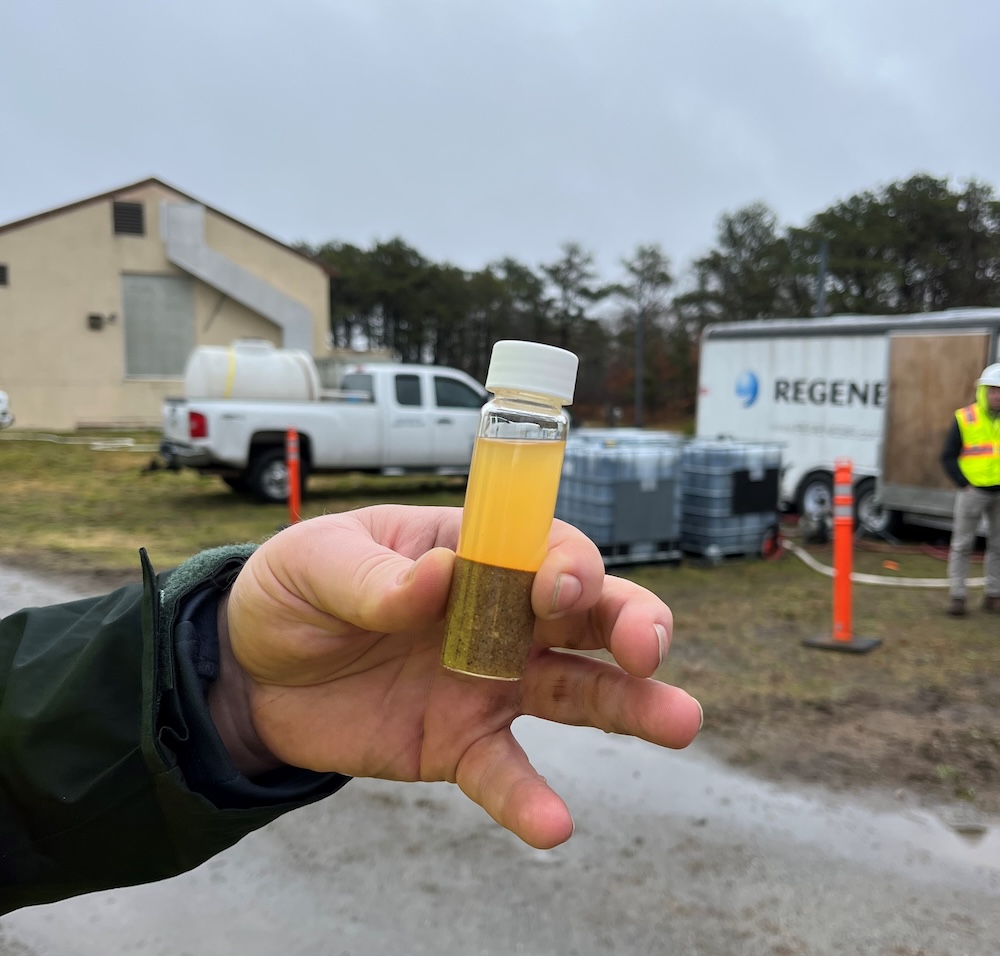
When PFAS met CAC
“I think we were the first people to use [CAC] in situ anywhere in the world,” said Rick McGregor, a hydrogeologist and the president and CEO of InSitu Remediation Services Ltd., headquartered in St. George, Ontario. “There was a site here in Canada near Ottawa, Ontario, that we were hired by a consulting firm and the owner of a property to remediate petroleum hydrocarbons.”
McGregor’s team used a colloidal activated carbon product called PlumeStop, made by the environmental remediation solutions company Regenesis, for that original purpose. But serendipity stepped in to enlarge the project’s scope when the end-client’s consultant mentioned that firefighting training had taken place on the site.
“This is back in 2016. Things were starting to emerge about PFOA and PFOS [perfluorooctanoic acid and perfluorooctanesulfonic acid, two types of PFAS] in firefighting foam, so I grabbed some water samples from the wells before we injected [PlumeStop] and sent those samples off to be analyzed,” McGregor said.
Tests revealed PFAS present at the site. The good news? PlumeStop captured the two PFAS chemicals in question, along with 12 others, reducing the two to barely detectable levels and the others below their respective measurable limits over the first 18 months of periodic testing. The U.S. Environmental Protection Agency (EPA) recently proposed a maximum contaminant level of 4 parts per trillion for PFOA and PFOS, which is as low as tests can detect, but the ultimate goal is zero.
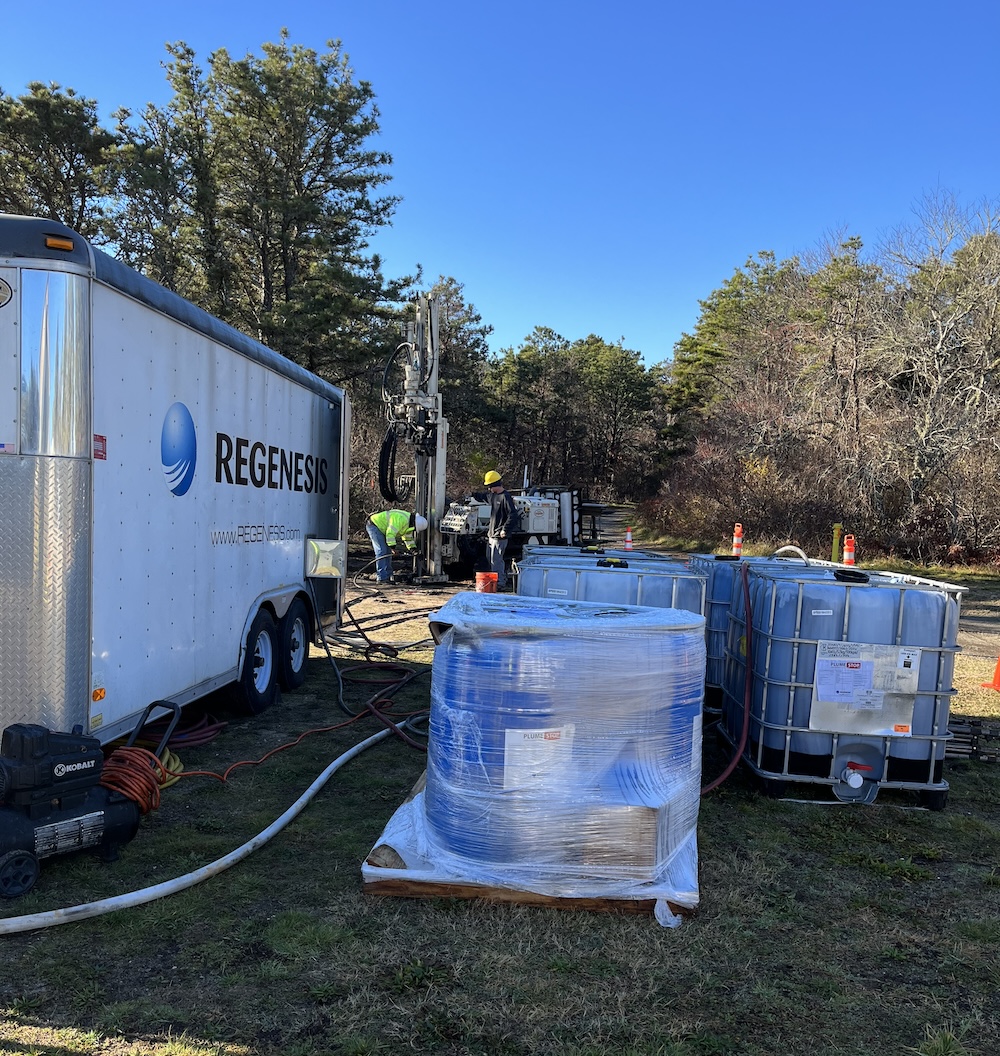
Tiny particles, big result
Maureen Dooley, the vice president of Regenesis’ industrial sector, said the company now has over 550 in situ colloidal activated carbon installations serving various industries, airports and military sites. PlumeStop was launched in 2014, first to address petroleum hydrocarbons and chlorinated solvents, and is now also used to remediate PFAS.
For any filtration to be successful, the filter has to be the right size. For comparison, standard air filters for household HVAC systems often run 5 to 10 microns. For whole-house water systems, 5 to 50 microns is the common range. The smaller the number, the greater the filtration because the pores of the filter are smaller. But that can mean a higher tendency to clog or reach holding capacity and need more frequent replacement.
“You can't catch a mosquito with a chain link fence,” Dooley said. “Colloidal activated carbon is 1 to 2 microns in size. So, that's like the size of a red blood cell or a bacterium. The smaller size of the colloidal carbon has a lot more surface area.” That translates to faster adsorption of contaminants like PFAS as the molecules attach themselves to the carbon surfaces.
The solution carrying the carbon is pushed below ground to surround the soil particles at a distribution thickness that meets each site’s needs. That coating creates an underground filter.
“I’ve used the analogy that we are painting the soil … roughly a 10-micron-thick coating around the soil particle that is not going to impede groundwater flow,” Dooley said. In some cases, other compounds can be added to promote biodegradation of other materials hitting the colloidal activated carbon barrier.
Colloidal activated carbon comes with benefits, but limitations remain
The science and engineering needed to utilize colloidal activated carbon may be complicated, but its benefits are easy to comprehend, even beyond its remediation effectiveness.
“Containment is the only feasible remedy currently available for treating PFAS in groundwater,” Dooley said, noting that destruction of the strong carbon-fluorine bonds in PFAS is both energy-intensive and expensive. At least for the present, destruction technologies simply aren’t yet suited for addressing PFAS underground, being better applicable to water above ground, such as at landfills and wastewater treatment plants.
Because in situ colloidal activated carbon does not extract contaminated water from the ground and place it in containers for treatment, known as “pump and treat,” it eliminates a lot of expense and carbon emissions caused by transferring either treatment equipment to the site or contaminated water to a treatment facility. It also “ensures communities do not become exposed to additional PFAS risk during the handling, transport and disposal of these wastes,” Dooley said.
If in situ colloidal activated carbon has a weakness, McGregor said it would be “breakthrough" — in other words, PFAS bypassing the carbon and moving through the pores along with the water. This can happen with “short-chain” PFAS, which have fewer carbon molecules than “long-chain” PFAS.
That makes short-chain PFAS more soluble in water and less attracted to the carbon in the colloidal activated carbon filters. Even long-chain PFAS, which are less soluble and have a greater attraction to the carbon, can break through if the colloidal activated carbon filter reaches its capacity, similar to an overly saturated sponge.
Both McGregor and Dooley said adding follow-up applications of colloidal activated carbon to soils can address breakthrough on an ongoing basis.
Plus, follow-up studies and modeling since the 2016 Ottawa installation, including a report by Dr. Grant R. Carey et al that included McGregor, show that colloidal activated carbon has longevity for continued effectiveness and durability as it quietly does its work underground for several decades.
Those decades buy a lot of time to remediate PFAS contamination, as well as to allow additional treatment and testing technologies to develop and become economically feasible. More time means more knowledge about PFAS, better regulations and safer alternatives to PFAS for products.
The U.S. Department of Defense is looking for safer fire suppressants to match the effectiveness of currently used PFAS-containing foam. That’s critical given explosive ordnance is housed on bases. If firefighting foam seems to get more than its fair share of attention over other products containing PFAS, Dooley shared an important thought: “Firefighting foam is so pervasive. Every community has or had a fire-training area,” she said.
In situ colloidal activated carbon is proving itself effective not only against PFAS in firefighting foam entering groundwater, but also with discharges and run-offs at manufacturing sites, landfills, refineries and storage facilities. In the remediation train to get PFAS out of drinking water and the environment’s water cycle, fixed-location colloidal activated carbon holds an early car position behind the solutions locomotive.
Diversity Without Inclusion Is a Missed Opportunity: How Employees Can Speak Up


(Image: nanzeeba/Adobe Stock)
Toxic workplaces have the power to do a lot of harm. Employees feel the effects mentally and physically, and productivity suffers as a result. Naturally, turnover is high in toxic work environments, and employers struggle to retain top talent. But discrimination, harassment and bullying are preventable. It’s up to employers to foster healthier workplaces that truly value diversity, equity and inclusion (DEI), but employees can also find their voice to speak up and hold leaders accountable.
TriplePundit spoke with Chiquita Hall-Jackson, an attorney and expert in employment law, about what can be done to promote employee wellness and inclusion, and what employees can do if they witness discrimination or mistreatment at work.
Diversity without inclusion leads to missed opportunities
“A lot of companies have been focusing on diversifying their staff and their workforce,” Hall-Jackson said. “However, they're not being inclusive, and that's where a lot of opportunities have been missed.” It’s not enough to just hire a diverse staff. By ignoring inclusion, many employers miss out on the benefits that come with a diverse workforce. After all, employees have to feel included to be comfortable sharing their ideas and talents.
Employees need to feel like they have a voice in the workplace and can offer input, she said. “They also want to contribute and show that their talents are recognized by the company.”

Inclusion through bonding experiences
Hall-Jackson sees bonding experiences during the workday as a simple step employers can take to foster employee wellness and connection. These group activities could include mixers, cooking lessons, exercise classes, and paint and sip classes. “Different activities that you used to do with your girlfriends or a bunch of friends, corporate is now evolving as bonding activities,” she said.
These experiences cultivate inclusion, employee happiness and a sense of belonging, she said. “A lot of people just don't feel like they belong in the workplace, and ultimately it affects their mental health.” Offering bonding experiences can help workers who don’t feel valued or engaged to feel included.
Resources for reporting workplace issues
A strong social support system in the workplace is the backbone of inclusion and employee well-being, Hall-Jackson said. That means fostering an environment of respect and fair treatment, supporting an open-door policy for communication between workers and supervisors, and creating a human resources policy against discrimination and harassment.
When it comes to reporting discrimination, harassment and bullying, employees feel safest if there is a third-party phone number they can call instead of reporting to internal human resources personnel, she said. The option to remain anonymous can also protect them from retaliation.
Likewise, she encourages employers to use a third party to handle issues that arise while safeguarding employee privacy — for example, requests for leave related to medical issues and disabilities. She gave the example of a client whose supervisor left the mental health records she submitted for a leave request on a desk where anyone walking by could see the employee’s personal, protected health information. Utilizing a third party to process these records would have protected the employee from the embarrassment of sharing such personal information with her supervisor and exposing it to others in the office.
A budding movement rallies workers to speak up about wrongdoing
Hall-Jackson wants employees to be able to use their voices to stick up for what’s right and intervene when they witness harmful behavior like microaggressions and discrimination at work.
“They might even see their supervisors yelling and picking on a particular individual or group of individuals,” she said. “If you don't feel comfortable speaking up in that moment, maybe immediately after — I'll say no more than 24 hours after that particular meeting, or interaction — pull that person to the side and say, ‘Hey, I witnessed what happened. I don't think that's fair. I think you owe XYZ an apology. And that's not how we do things around here.’" Letting people know you're against this type of behavior and don't think it's good for the company draws a clear boundary and establishes that you won't look the other way, she said.
Hall-Jackson founded Blow the Whistle Law to facilitate more speaking up. The "social justice and accountability movement" aims to institute workers’ rights clinics in at least 10 law schools across the U.S. to train law students to disrupt wrongdoing and prioritize diversity in the workplace, she said.
“It was sparked after being triggered by the Black Lives Matter movement back in 2020,” Hall-Jackson said. “When I, personally, had the belief that if the officers who were with Derek Chauvin had intervened that day when he had his knee on George Floyd's neck, that his life could have been saved.”
The limits of employment law
The Blow the Whistle Law movement holds monthly webinars around workplace issues. One of the most popular is about identifying discrimination and how to navigate a hostile work environment. It’s important that employees can distinguish discrimination and harassment from workplace bullying, because perpetrators are emboldened when employees rush to file lawsuits or Equal Employment Opportunity Commission claims for bullying and, inevitably, lose those claims, she said.
“Unfortunately, there are no workplace bullying laws in place,” she said. And unless the mistreatment is related to a protected class, “what they're describing is not discrimination. It is simply workplace bullying or some kind of petty offense that's not covered under the law.”
This is why it’s all the more important for employers to value their employees’ well-being by proactively creating inclusive work environments and safe ways for employees to report mistreatment. Simultaneously, bonding activities can help co-workers feel more inclined to speak up for one another. Ultimately, it is up to employers to ensure their workplaces are not toxic, but employees can help protect each other by educating themselves on employment law and speaking up when they see mistreatment.
Cultivating Conservation: The Interconnected World of Agriculture and Freshwater Mammals


From hippopotami, platypuses and otters, to beavers, minks and river dolphins, freshwater mammals around the world are under threat. (Image: Chris Stenger/Unsplash)
Freshwater ecosystems like marshes, streams and lakes cover just a sliver of our planet, but they’re powerhouses of diversity. Nearly 10 percent of all animal species are found in these blue oases — a charismatic group of freshwater mammals that includes charging hippopotami, curious platypuses and frolicking otters.
Unfortunately, freshwater systems are one of the most threatened places on Earth. Over two-thirds of our wetlands have vanished since 1900. Similarly, nearly a third of freshwater mammals are threatened, and their numbers are declining faster than other furred and lactating creatures.
However, we can help the beavers, minks and river dolphins of the world with changes in an unexpected area: agriculture. Even in an industry that often harms freshwater systems, mitigating the impacts of the agriculture sector on our planet’s tranquil pools and bubbling waterways is possible.
Threats to freshwater mammals
Agriculture harms freshwater mammals in multiple ways. While hunting, fishing and logging weigh in as the main risks to freshwater mammals, agriculture is a close second.
An obvious impact of agriculture is habitat destruction. In fact, a major driver of wetland conversion is food production. Besides outright habitat destruction, agriculture also degrades freshwater habitats.
“A big thing we're still dealing with is the sins of the past where wetland loss occurred throughout the history of agriculture,” said Brian Jennings, a fish and wildlife biologist at the U.S. Fish and Wildlife Service. “Back in the '50s and the '60s, they were going in and ditching and draining wetlands and then actively farming them. In Delaware and other places on the coastal plain, the problem was you didn't have enough elevation to get the water off the field. So, they started channelizing streams to lower the elevation and drain the [agricultural] lands. But they didn't take into consideration the natural channel function, so you get a lot of sediment issues and bank erosion from these channelized streams.”
In addition to these issues, runoff from agriculture is a main source of pollution for rivers, lakes and wetlands. Excess nutrients from fields can be washed into nearby waterways, potentially fueling dead zones, fish kills and algal blooms. Finally, agriculture is also the largest consumer of freshwater globally, competing directly with these ecosystems.
Besides the threats across the crop world, urban development, invasive species, pollution, climate change, dams and water management systems menace freshwater mammals. It’s no wonder 44 percent of their species are declining.
The benefits of buffer zones
Fortunately, there are many ways to reduce the harmful effects of agriculture. First of all, maintaining buffer zones — or strips of land and vegetation along the banks of water bodies, also called riparian areas — is important for wildlife.
“The whole riparian area acts as travel corridors for different species, whether it's birds, mammals, amphibians or reptiles,” Jennings said.
Buffers with native vegetation improve habitat for animals by filtering and cleaning the water, stabilizing stream banks, mitigating floods, reducing and regulating water temperatures, and uptaking carbon.
Yet agricultural livestock prefer riparian areas because they provide abundant food, water and shade. They can degrade these sensitive areas — changing stream channels, trampling banks, increasing erosion, and reducing plant and animal diversity.
A simple solution to this problem is keeping livestock away from these areas. Fencing can protect riparian areas, while supplying alternative water sources can attract livestock away from streams. This can lead to dramatic habitat improvements. For example, excluding livestock from riparian areas in Oregon substantially improved the diversity and abundance of native vegetation.
While buffers are good for the environment, farmers may oppose giving up otherwise usable land, Jennings explained. A forested buffer can also interfere with irrigation systems, and shading may affect nearby crops. However, incentive payments, like those offered by the U.S. Department of Agriculture’s Conservation Reserve Program, can encourage farmers to adopt conservation practices on their land.
Improving water quality
Buffers aren't the only way farmers can help protect freshwater habitats and their furred inhabitants. For instance, farmers can reduce pollution from their farms by adopting best management practices for nutrients. These involve applying the correct type of fertilizer at the right time, place and amount.
Planting cover and perennial crops to reduce soil erosion can also be helpful. Another method is conservation drainage techniques, which involves filtering water through trenches filled with wood chips to remove nutrients and modifying ditches and drainage systems.
For instance, best management practices on agricultural lands in Florida reduced phosphorus pollution entering the Everglades by an average of 55 percent. These practices included leveling fields to reduce soil erosion, constructing berms (or raised banks) along ditches and canals to reduce runoff, and cleaning sediments out of canals, among other actions.
Reducing water use
Tamping down on water use is another way to shrink the oversized reach of agriculture into freshwater ecosystems. For example, drip irrigation, where tubing is placed on or under the soil, reduces evaporation, as does scheduling irrigation for cooler parts of the day. Sensors that detect soil moisture can reduce unnecessary water use on farms, too.
In addition, cover crops and mulch cool the soil, reducing evaporation. They also lock up nutrients in the soil and allow for reduced fertilizer use, saving farmers money, Jennings explained.
Along with no-till practices (or not plowing the soil) and compost, these methods increase organic matter in the soil, and in turn, improves its ability to hold water. However, no-till practices may require spraying herbicides since mechanical treatments to suppress weeds aren’t an option.
A similar problem exists with organic production. “The big problem with organic farming is you have to turn the soil over since that's your weed control,” Jennings said. “There are no approved organic herbicides that are really effective on weed control.”
In the quest for more sustainable agriculture and healthier ecosystems, some tradeoffs are inevitable.
Safeguarding freshwater mammals
All this effort may sound laborious, but after all, freshwater mammals are a valuable group. For instance, the industrious beaver creates wetlands, improves water quality, reduces erosion, increases plant and animal diversity, and minimizes the risk of flooding. Hippos, perhaps better known for their aggression, also transfer silicon into rivers and lakes. Silicon, in turn, is a vital nutrient for diatoms (or algae) that make up the base of the food chain feeding aquatic insects and fish.
While the threats to freshwater mammals are numerous, there are nearly as many ways to protect them. Changing agricultural practices is one major step forward.
These Climate Solutions Could Get Us Halfway to Capping Temperature Rise at 1.5 Degrees
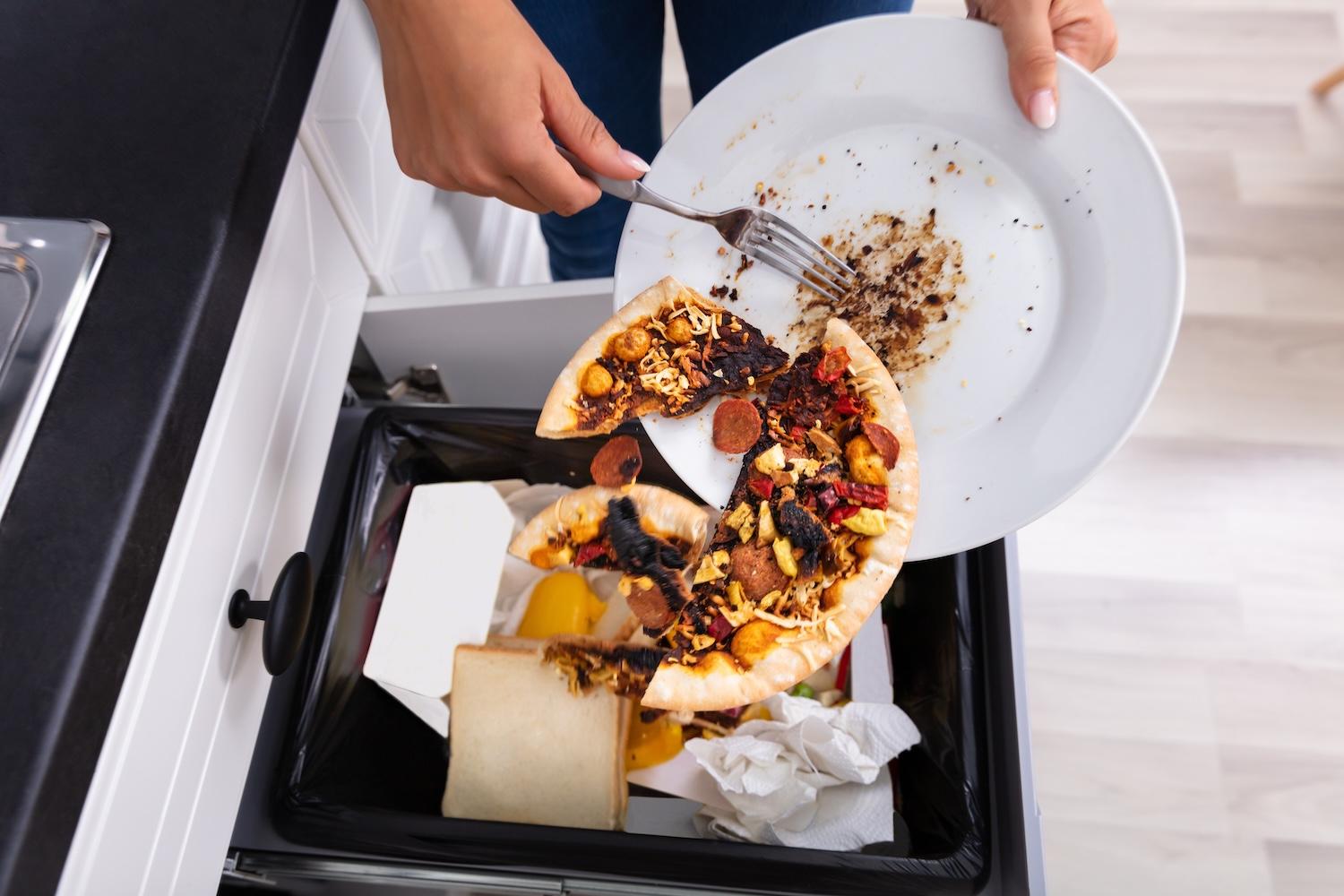

It may be hard to believe, but one of the highest-potential climate solutions out there isn't renewable energy or electric cars, but rather wasting less food. (Image: Andrey Popov/Adobe Stock)
In case you missed it, TriplePundit relaunched last week with a focus on solutions journalism. Since then, we've taken a look back at some of the environmental, social and economic solutions we covered in the past — and if they became "the next big thing" as once promised or eventually faded away. Now, we're looking ahead at some of the most promising solutions the science tells us can have a measurable impact on the environmental, social and economic challenges we face.
When it comes to the environment — and climate change in particular — we don't need to wait for yet-to-be-invented technologies or multi-trillion-dollar investments in order to make progress. Proven climate solutions that are scalable today can get us most of the way toward capping global temperature rise at 1.5 degrees Celsius this century and avoiding the worst impacts of climate change.
Reduce food waste
Cutting food waste in half globally by 2050 would amount to 88.5 gigatons in avoided carbon equivalent emissions, according to the nonprofit Project Drawdown, which pulls from peer-reviewed research and projections to quantify the potential of various climate solutions. That's around 15 percent of the estimated 570 gigatons of avoided emissions necessary to cap global temperature rise at 1.5 degrees Celsius. Of the 90 potential climate solutions in Project Drawdown's tracker, reducing food waste has the greatest projected potential to cut emissions.
That may come as a surprise: Most people think about renewable energy, electric vehicles or battery storage first when it comes to fighting climate change. It turns out wasting nearly a third of the food we produce globally is not only terrible for people, but it's also a major greenhouse gas emitter. Food waste accounts for around half of all emissions associated with the global food system, according to a 2023 study published in the peer-reviewed journal Nature Food.
In lower-income countries, most food is wasted accidentally at the field level or during storage. In wealthier countries, it's more likely to go to waste at retailers and restaurants or in people's homes. Evidence-based solutions exist to address food waste along the value chain. A landmark 2019 effort from the World Resources Institute's Champions 12.3 initiative helped 114 restaurants across 12 countries cut food waste by half or more, while saving $7 for every $1 invested, using methods that are easily replicable. On the field, crops typically considered waste can be diverted for other uses, such as through "ugly" produce companies or alternative products like cosmetics or fuels.
But vast untapped potential still exists — for example, countries and companies leveraging climate finance to help farmers in developing markets invest in mechanical harvesting equipment and food storage, or local stakeholders working to address some of the social causes of food waste at the consumer level (which can include things like long walks to the nearest grocery store). Keep an eye on TriplePundit for more coverage of food waste and climate solutions like these. If you have a tip, please send it here!

Adopt a more plant-based diet
We know, we know. The mere suggestion of cutting out animal products can be polarizing, eliciting cheers or gasps depending on your circles. But adopting a more climate-friendly diet doesn't have to mean cutting out meat entirely. Even eating less meat and dairy can carry major benefits in the fight against climate change.
If half of the global population ate a more "plant-rich" diet — specifically limiting red meat to 57 grams per day, which amounts to a burger or steak a couple times a week — we'd avoid 78.3 gigatons of carbon equivalent emissions, according to estimates from Project Drawdown. Other recent research came to similar conclusions.
That means eating a bit less meat and throwing out half the food we do now could get us nearly a third of the way toward avoiding the 1.5-degree threshold scientists agree is critical. That's some pretty serious — and if you ask us, seriously exciting — stuff.
The boom in plant-based meat options could serve to convince the uninitiated they may not need meat at every meal. But a lot of this will likely boil down to education and access — in other words, high-quality, local animal products and produce being accessible at affordable prices and people feeling confident using it in their kitchens. This will be top on our coverage list with our new solutions focus, too. Please share any tips here.
Tropical reforestation
Globally, forests act as a carbon sink, with trees and plants sucking carbon from the air and storing it in the soil. Tropical forests in particular are estimated to store around a quarter of the world's carbon. But degradation and rising temperatures mean tropical forests aren't able to suck up as much carbon as they once did, so restoration is critical.
Adopted by U.N. member states and civil society stakeholders in 2014, the New York Declaration on Forests calls for stopping global forest loss and restoring 350 million hectares of forest by 2030. The latest progress report, published this week, indicates the world is far off track.
Global stakeholders need to cut forest loss by 10 percent per year to halt deforestation by 2030, but rates of deforestation are still increasing and backslid last year after modest gains in 2021. Global gross deforestation is 21 percent higher than needed to reach the goal, and the state of primary tropical forests is even worse, with losses 33 percent higher than what's needed to halt tropical deforestation by 2030.
But all hope is not lost. Tropical Asia is the closest of all global regions to halting deforestation, with Indonesia and Malaysia achieving sustained reductions in tropical forest loss, according to the assessment. Further, restoring 350 million hectares by 2030 was always a stretch, and making even some progress toward that aim can have significant benefits in reducing greenhouse gases in the atmosphere.
Restoring around 161 million hectares of tropical forest by 2050 could avoid nearly 55 gigatons of carbon equivalent emissions, and restoring 230 million hectares could avoid more than 85 gigatons, according to estimates from Project Drawdown. But forest restoration isn't just about tree-planting, and recent research indicates that widespread tree-planting programs aren't having the level of impact organizers would like. Some forestry experts are calling for a new approach, called forest landscape restoration, that provides for overall ecosystem health and community well-being. Climate solutions like this will be central to TriplePundit's ongoing coverage of forest protection and reforestation. If you have tips to share, please do so here!
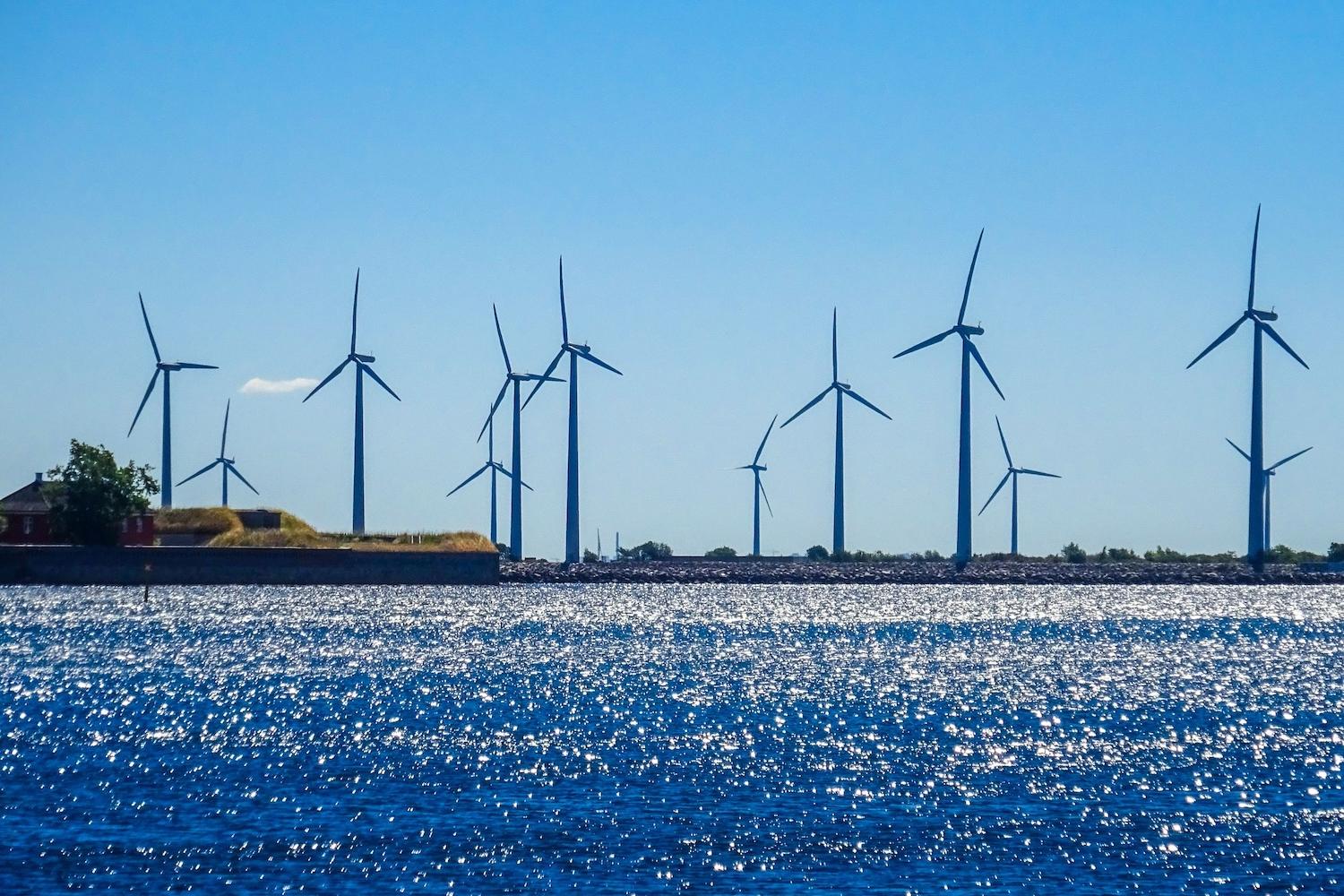
The rise of renewables
Renewable energy is what most people think about when they consider the fight against climate change, and it certainly has the potential to play a major role. Together, wind and solar accounted for 12 percent of global electricity generation in 2022, according to a recent analysis from the U.K. think tank Ember Climate. Electricity generation from wind and solar increased by 19 percent from 2021, while global coal generation increased by just over 1 percent and gas declined by .02 percent.
The signs that fossil fuel power generation may have peaked are encouraging, and keeping the momentum up will have outsized impacts on fighting climate change. Increasing onshore wind power to 20 percent of global electricity generation by 2050 — fairly modest progress from around 7.5 percent today — could result in nearly 47 gigatons of avoided carbon equivalent emissions, according to estimates from Project Drawdown. Going further, to 27 percent, could amount to nearly 144 gigatons of emissions avoided. Meanwhile, meeting 21 percent to 25 percent of global power needs with utility-scale solar could avoid around 41 to 111 gigatons of emissions by 2050. Further gains — up to around 64 gigatons — could come from scaling up rooftop and home solar.
That means, even on the low end of these estimates, continuing to scale up renewables at an aggressive pace could bring the world a fifth of the way toward avoiding the 1.5-degree threshold. On the higher end, we'd be over halfway there. And that doesn't even take into account other fast-developing renewable technologies like offshore wind and green hydrogen made from water, which is on pace to surpass price-parity with hydrogen made from natural gas within a decade. Of course renewable energy — from the standards like onshore wind and utility-scale solar to emerging models — will continue to be central to TriplePundit's coverage of climate solutions. Please share any tips here!
Beyond climate solutions: Evidence-based ways to improve the environment
Okay, let's break out the calculators: Even on the lower end of these estimates, these four climate solutions could get the world over halfway toward avoiding the 1.5-degree threshold. On the higher end, we'd be there with these solutions alone.
Importantly, all of these targets are attainable based on where we are now and the technologies we already have at hand. That's not to say we shouldn't do anything else, but we also don't need to wait around to crack the code. We can do more now, and millions around the world already are.
And the global carbon budget isn't the only area where proven solutions can make a massive impact on the challenges we face. When it comes to biodiversity, interventions like protected wildlife corridors have been shown to combat extinction and safeguard at-risk species. Considering that around 80 percent of the plastic waste that enters the ocean comes from rivers, river-based interventions have vast potential stem the tide and give the world more time to fight the problem.
TriplePundit is keeping a close eye on environmental and climate solutions like these, and we look forward to exploring them further through the lens of solutions journalism. Please share any and all feedback with us, and we're excited to have you on this journey!
Inflation Reduction Act Sparks a Clean Energy Boom in the U.S.

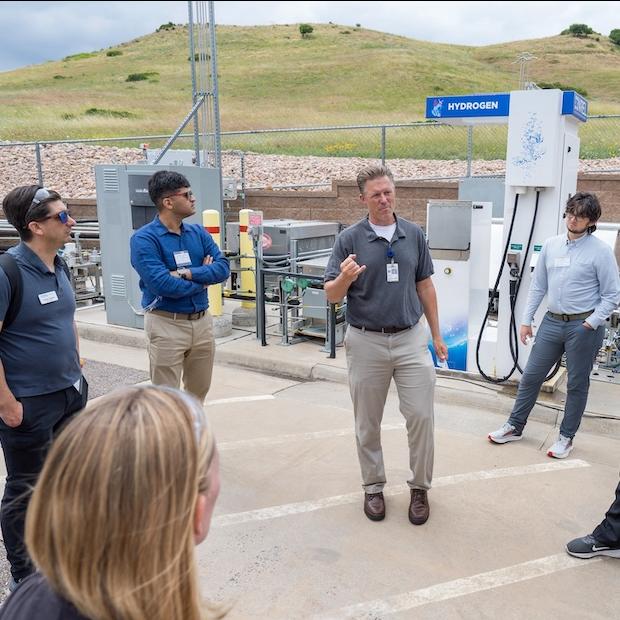
Participants in the National Renewable Energy Laboratory’s Executive Energy Leadership Academy tour NREL's main campus in Golden, Colorado, to learn more about renewable energy and energy-efficiency technologies. (Image: National Renewable Energy Laboratory/Flickr)
Investors are responding to new incentives under the U.S. Inflation Reduction Act of 2022 with a flood of big, multi-megawatt commercial clean energy projects. That has grabbed the media spotlight, but the clean energy impact of the legislation can also be seen in provisions that support energy-efficiency improvements for small businesses, too.
It was always about the clean energy
The name Inflation Reduction Act is something of a misnomer. The key provisions of the IRA support projects that foster a low-carbon economy. The Joe Biden administration’s official guidebook on the IRA begins with this observation: “On August 16, 2022, President Biden signed the Inflation Reduction Act into law, marking the most significant action Congress has taken on clean energy and climate change in the nation’s history.”
Last year, the Congressional Budget Office assessed that the IRA would have little to no effect on inflation through 2023, though inflation did cool down this year due to other factors.
In contrast, there is clear evidence that the tax credits and domestic manufacturing provisions of the IRA have sparked a clean energy boom that includes overseas investors as well as U.S. firms.
In August, for example, the sustainable business organization E2 counted 210 new clean energy projects announced since August 2022, spread among 38 U.S. states. About half of the projects are credited to overseas firms, indicating that the international business community is more motivated to create new manufacturing jobs in the U.S. rather than elsewhere.
E2 also observed that the law benefited Republican districts by a wide margin, even though the IRA passed along party lines with no Republican votes. “Republican districts accounted for 72 percent of the jobs estimated to be created and 86 percent of the new investments,” E2 assessed.
E2 updated its list in September to add 13 new projects, spread over 11 states. As with the earlier announcements, the new additions indicate that investors have been politically agnostic in their choice of location, with Republican and Democratic districts benefiting alike.
Together, the 13 new projects flagged by E2 are expected to drive a total of $2.7 billion in private investment. They range in size from an $8.4 million shipyard expansion planned by the U.S. firm Loyd Shipyard to serve the offshore wind industry in Virginia, to a $2 billion electric vehicle battery factory announced by the Chinese company Gotion in Illinois.
Beyond the private sector
In addition to spurring private-sector investment, the clean energy provisions in the IRA unlock the benefits of tax credits for tax-exempt entities, including the nation’s sprawling, and influential, network of rural electric cooperatives.
The National Association of Electric Cooperatives takes credit for helping to shape the Department of Agriculture’s New ERA (Empowering Rural America) program within the IRA. The program covers a wide range of proposals including carbon capture, renewable energy, energy storage, and nuclear energy as well as generation and transmission efficiency improvements.
“Electric cooperatives flooded the U.S. Department of Agriculture with interest in a new $9.7 billion clean energy program, submitting proposals for hundreds of projects that would require at least twice that amount and launch $93 billion in new investment across rural America,” NRECA announced on September 23.
New review reveals untapped potential around energy efficiency
While high-dollar investments and new manufacturing jobs are key parts of the IRA, the provisions that enable ordinary businesses to partake in the low-carbon economy are equally important.
On Friday, the U.S. Treasury Department released a review of tax provisions in the IRA that help ease the financial path for households and small businesses to invest in energy-efficiency upgrades.
For commercial properties, the IRA expands the existing Energy-Efficient Commercial Buildings Deduction to directly reward energy-efficiency improvements. Under the new rules, a property owner’s deductions will increase in coordination with the cost savings resulting from their energy-efficiency investments.
The critical importance of energy efficiency
It is difficult to overstate the importance of energy-efficiency improvements in buildings. Energy efficiency has been called the low-hanging fruit of climate action because the technology is accessible and relatively inexpensive, and the timeline for implementation is relatively short.
“Energy efficiency is one of the easiest and most cost-effective ways to combat climate change, reduce energy costs for consumers, and improve the competitiveness of U.S. businesses,” the U.S. Department of Energy's website reads.
According to the Energy Department, commercial buildings consume 35 percent of electricity generated in the U.S. and produce 16 percent of all U.S. carbon dioxide emissions.
“Reducing energy use in commercial buildings would have tremendous positive impact in our environment and energy security, and would save money that can be used to help grow U.S. businesses,” according to the department. “In addition, energy efficiency in commercial buildings creates good, skilled and needed jobs in construction and technology, such as engineers, commissioning agents, energy managers, and building operators.
The bottom-line benefits of energy-efficiency upgrades
The Energy Department notes that an average of 30 percent of the energy used in commercial buildings goes to waste. On the bright side, that means the average building stands to gain considerable bottom-line benefits by improving their energy profile.
The new IRA provisions for commercial efficiency upgrades provide additional support for the Energy Department’s Better Buildings initiative. Launched during the Barack Obama administration in 2011, Better Buildings is a major public-private program that incentivizes building efficiency improvements across all sectors, including government, utilities, Tribal entities and other agencies.
Partnering in the program are almost a third of Fortune 100 companies and almost 40 percent of the top 50 U.S. employers. The program also encompasses about 14 percent of the nation’s manufacturing energy footprint and 13 percent of total commercial building space.
The Energy Department issued a progress report on the program on Monday. The 900 program participants have collectively saved more than $18.5 billion in energy costs since 2011. The upgrades they implemented reduced carbon emissions by almost 190 million metric tons, equivalent to the annual emissions of 24 million homes.
Who’s afraid of the ESG?
As a whole, the IRA provides strong support for the ESG (environment, social and governance) principles that have become mainstream guidelines for responsible businesses and investors. The law includes provisions for social equity and environmental justice along with bottom-line benefits.
Public officials in Republican-dominated states continue to rail against ESG principles and something called “woke capitalism.” However, so far their efforts have met with mixed, if any, success. Surveys indicate that asset managers continue to tune out the anti-ESG rhetoric, though some may parse their words more carefully when discussing ESG.
After all, money talks, and the IRA has plenty to say.